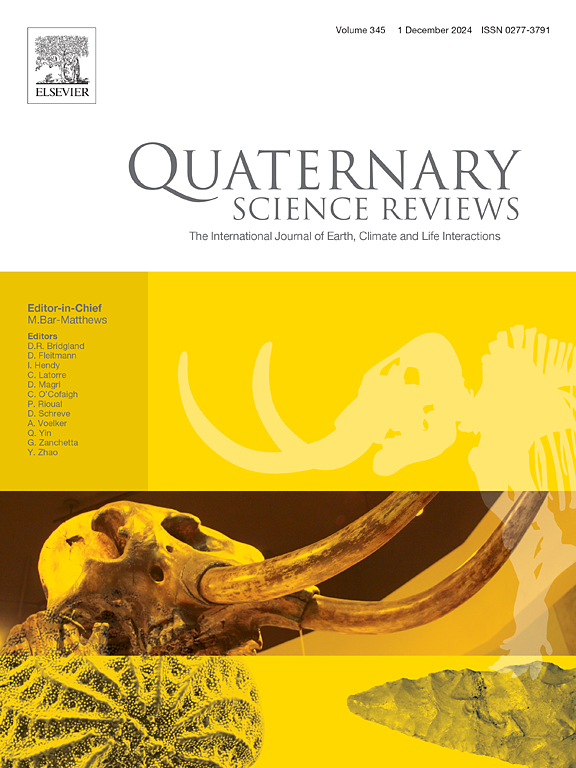Worldwide consequences of a mid-Holocene cold event in the Nordic Seas
IF 3.2
1区 地球科学
Q1 GEOGRAPHY, PHYSICAL
引用次数: 0
Abstract
The present interglacial is a relatively warm and stable period, especially compared to the preceding glacial time. However, the Holocene has seen the emergence of several remarkable cold events, some with worldwide consequences. Leveraging marine records from the Nordic Seas, we provide the first detailed account of a cold event centered around 6.8 ka BP. Utilizing paleoceanographic proxies and advanced modeling, we unveil a distinct subsurface water cooling, associated with a stepwise increase in sea-ice cover in the eastern Fram Strait. Our findings emphasize the role of Greenland Sea deep convection onset and the subsequent westward shift in Atlantic Water flow, enabling sea-ice advection from the Barents Sea. The heightened sea-ice cover weakened Atlantic Water advection, perturbing thermohaline circulation in the eastern Nordic Seas. These perturbations propagated worldwide, affecting North Atlantic deep-water circulation, inducing widespread hemispheric cooling, shifting the Intertropical Convergence Zone southward, and weakening the East Asian monsoon. Incorporating results from the Transient simulations of Climate Evolution of the last 21,000 years (TraCE-21ka) supports and augments proxy-based paleoreconstructions, underscoring sea-ice dynamics and ocean circulation's critical influence. This study highlights the potential for localized cold events within ostensibly warm climatic intervals. It underscores the need to comprehend their mechanisms for precise climate predictions and informed policymaking toward a sustainable future.
全新世中期北欧海域寒冷事件的全球影响
目前的间冰期是一个相对温暖和稳定的时期,尤其是与之前的冰川期相比。然而,全新世出现了几次令人瞩目的寒冷事件,其中一些影响波及全球。利用北欧海洋的海洋记录,我们首次详细描述了以公元前 6.8 ka 为中心的寒冷事件。利用古海洋学代用指标和先进的建模方法,我们揭示了与弗拉姆海峡东部海冰覆盖面积逐步增加有关的明显的表层下海水冷却现象。我们的发现强调了格陵兰海深层对流开始以及随后大西洋水流西移的作用,这使得海冰能够从巴伦支海吸入。海冰覆盖的增加削弱了大西洋水流的平流,扰动了北欧东部海域的温盐环流。这些扰动波及全球,影响了北大西洋深水环流,导致大范围半球降温,使热带辐合带南移,并削弱了东亚季风。结合过去 21,000 年气候演变瞬态模拟(TraCE-21ka)的结果,支持并增强了基于代用指标的古重建,强调了海冰动力学和海洋环流的关键影响。这项研究强调了在表面温暖的气候区间内发生局部寒冷事件的可能性。它强调了理解其机制的必要性,以便进行精确的气候预测和知情决策,实现可持续的未来。
本文章由计算机程序翻译,如有差异,请以英文原文为准。
求助全文
约1分钟内获得全文
求助全文
来源期刊

Quaternary Science Reviews
地学-地球科学综合
CiteScore
7.50
自引率
15.00%
发文量
388
审稿时长
3 months
期刊介绍:
Quaternary Science Reviews caters for all aspects of Quaternary science, and includes, for example, geology, geomorphology, geography, archaeology, soil science, palaeobotany, palaeontology, palaeoclimatology and the full range of applicable dating methods. The dividing line between what constitutes the review paper and one which contains new original data is not easy to establish, so QSR also publishes papers with new data especially if these perform a review function. All the Quaternary sciences are changing rapidly and subject to re-evaluation as the pace of discovery quickens; thus the diverse but comprehensive role of Quaternary Science Reviews keeps readers abreast of the wider issues relating to new developments in the field.
 求助内容:
求助内容: 应助结果提醒方式:
应助结果提醒方式:


